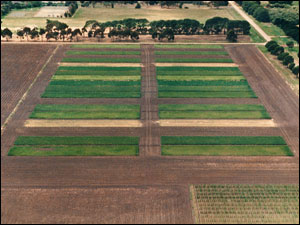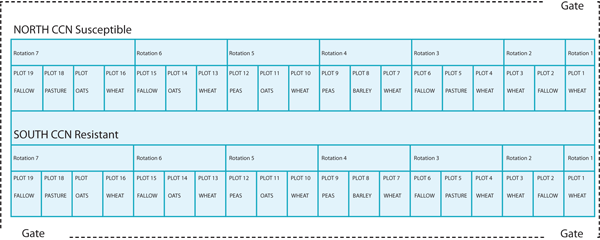Longerenong Rotation No.1 (LR1) - Longerenong
|
The LR1 experiment was established in 1916 to investigate the suitability of various cropping rotations on soil fertility within the Wimmera. |  Aerial photograph of the LR1 experimental site at Longerenong |
Outputs
The LR1 site has provided comparison of wheat yield depending on the crop rotation used. It has also provided measurement of the rate of deep drainage (secondary salinity), and defined the effects of different rotations on the incidence of soil borne root diseases in cereal crops. Scientific publications arising from this site are listed below.
The LR1 site is also used regularly as a resource for post graduate students within collaborative projects, where it provides a known history of management and rotation treatment.
Experimental Design
Crop rotations (1 to 3 course) trialled at the LR1 site in Longerenong from 1916 to 1986 on plots of 14 metres by 50 metres included:
- continuous cereal
- cereal - fallow
- medic - fallow - cereal
- cereal - pulse - cereal
- cereal - pulse - cereal
- cereal - fallow - cereal
- cereal - medic - fallow - cereal
In 1986 the original plot design was modified where each plot was split in half to give a northern and southern block of plots. The southern block contains cereal cyst nematode (CCN) susceptible varieties (wheat cv. Ghurka; barley cv. Gairdner and oats cv. Swan), whereas the northern block contains CCN resistant varieties (wheat cv. Goldmark; barley cv. Barque and oats cv. Potoroo).
In 1986 the oats treatments that had been grazed began to be slashed, and subsequently these treatments became medic. In 2000, oats grain was replaced by canola for one year only.

Figure 1. Field lay out and site design of the LR1, Longerenong, Victoria. Example is for crops sown in 2010
Over the last century, regular sampling and analyses of various soil and plant properties has occurred. Crop growth and yield and climate data have been recorded annually. Grain quality, soil moisture, nitrogen and pathology are measured occasionally.
Related Publications
Richardson AEV (1924) Wheat and its cultivation. Journal of Agriculture, Victoria 22, 385-414.
Sims HJ and Rooney DR (1955) Wimmera cereal experiments: crop rotation trials. Journal of Agriculture, Victoria 53, 302-4.
Oades JM (1967) Carbohydrates in some Australian soils. Australian Journal of Soil Research 5, 103–115.
Hannah MC and O’Leary GJ (1995) Wheat yield response to rainfall in a long-term multi-rotation experiment in the Victorian Wimmera. Australian Journal of Experimental Agriculture 35, 951–960.
O’Connell MG, O’Leary GJ and Incerti M (1995) Potential groundwater recharge from fallowing in north-west Victoria, Australia. Agricultural Water Management 29, 37–52.
Trial custodian
Dr Roger Armstrong - roger.armstrong@depi.vic.gov.au


